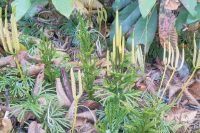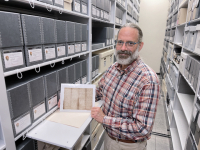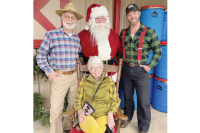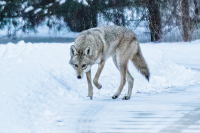Sunshine on Sam Knob: Ranger-led hikes help locals explore trails along Parkway
 Despite warnings of thunderstorms earlier in the week, Aug. 22 came with a blue sky and a light breeze, temperatures hovering around a sunny 70 degrees at the Black Balsam Trailhead. Gail Fox, a National Park Service ranger for the Blue Ridge Parkway, predicted fantastic views from the top of Sam Knob as a group of about 15 people gathered in the parking lot.
Despite warnings of thunderstorms earlier in the week, Aug. 22 came with a blue sky and a light breeze, temperatures hovering around a sunny 70 degrees at the Black Balsam Trailhead. Gail Fox, a National Park Service ranger for the Blue Ridge Parkway, predicted fantastic views from the top of Sam Knob as a group of about 15 people gathered in the parking lot.
“I had wanted to come here a long time, and I thought coming with a group would be fun,” said Arden resident Aprill Rhodes, a camera strapped around her neck.
There were plenty of reasons to have a camera at Black Balsam that day. After climbing up a small rise out of the parking lot, the trail flattened out across a treeless meadow, where tall grasses and abundant late summer flowers waved gently in the breeze. By this point in the year, Fox’s co-leader Mary Lou Glennon said, the flowers are mostly composites, species whose colorful faces are made of a bunch of tiny flowers pressed together — flowers that form Queen Anne’s lace, angelica, daisy. Bright purple blazing stars, butterfly-laden bull thistle and the last hurrah of fireweed rounded out the show.
The group spread out along the trail where Glennon and Fox had stopped to point out the rainbow of species around them, alternately listening to the talk and simply drinking in the surroundings.
“This is so incredibly lovely,” Rhodes said.
It was only Rhodes’ second time in nine years on the Sam Knob trail, but she’s hiked plenty of others led by Blue Ridge Parkway rangers. The hikes run weekly from late May to mid-October, usually somewhere under 3 miles, always somewhere on the Blue Ridge Parkway or very near its property. Though the Black Balsam area is U.S. Forest Service property, the trailhead is accessible only through a short, bumpy road off mile 420 of the Parkway.
Related Items
Most ranger programs in the National Park System attract mainly out-of-town visitors, but the Parkway hikes are a little different in that they mostly draw from the local crowd.
“We get some families [on vacation], but we do kind of have this core group,” Fox said. “We get a lot of locals from Asheville, Brevard, Waynesville.”
Refined by fire
The location varies from week to week — sometimes east of Asheville, sometimes west. So does the difficulty. With a 2.5-mile roundtrip and a little over 500 feet of elevation gain, Sam Knob is on the upper end of exertion for a Parkway Hike of the Week, but it’s still one of the easiest summit hikes around.
And it comes with one of the most interesting ecological histories. Hearing the story provided a great excuse to stop and rest for a while after the trail left the meadow and began to climb through a deciduous forest heavily populated with yellow birch. Reaching a rocky outcrop surrounded by blueberries on one side and a view of the valley on the other, Fox launched into her tale.
“This area has been affected by a lot of time and a lot of change,” she said.
To start with the mountains’ formation would dredge up eons of history, but even just going into the past couple hundred years brings up plenty worthy of discussion.
Back in the mid-to-late 1800s, a powerful windstorm kicked up in the mountains, felling countless trees for miles around. Then logging came into the area, cutting down what remained and hauling it off on a long-gone mountain railroad. And in 1925, a red-hot forest fire burned 25,000 acres of land where wild blueberries now grow.
“It wasn’t just your regular forest fire,” Fox said. “It was a fire that burned so absolutely and completely that it sterilized the soil. Then it rained.”
The rain carried off the scorched earth, leaving a moonscape behind that would take years to restore itself to a functioning ecosystem. That’s why, nearly 100 years later, the area is still mostly meadow, flourishing with grasses and wildflowers as few places do in the Appalachians, where trees sometimes seem to grow like weeds. Over time, the trees will likely return, but it’s hard to know for sure. From her vantage point on the mountainside, Fox pointed out a distinct line running down the opposite slope: shrubby meadow on one side, spruce-fir forest on the other.
It’s things like that which an untrained eye attached to a solo hiker might not notice, or be able to decode. By joining these guided outings, hikers get the chance to see things through an expert’s eyes in a way that’s a little more active than sitting through a 45-minute campfire lecture.
“You learn a little bit more than when you’re on your own,” said Peggy O’Donnell, an Asheville resident who came out with her husband to celebrate her 66th birthday.
That’s a benefit of keeping the hikes short. There’s plenty of time to stop along the way, whether to take a photo, point out an interesting flower species or simply catch a breath.
Community on the trail
Breath is important not only for walking. It’s also a vital ingredient for talking, something that happens quite a lot in the course of a hike, especially among people who find themselves sharing the trail with each other week after week.
“It’s like a little hiking club,” Fox said.
Emerging out onto the bald, that “club” takes a collective breath. The waves of the Blue Ridge peak out behind the closer mountains that rise green from the mountain valley. The sun shines on Courthouse Rock, on the tree-dotted meadows across the valley, on hats and arms and t-shirts. Some people break out the snacks. Some break out the camera. Some head over to the blueberry bushes.
“I’d rather do this than Disney World any day,” says Lester resident Douglas May.
The clarity of a sunny day at 6,000 feet makes it hard to disagree, especially when there are wild blueberries ready for the picking. Sunshine makes it easy to smile.
By the time we make it back to the trailhead, it’s after 1 p.m. Less than 3 miles in three hours might not be the best time record, but sometimes a trail is about more than just the destination. It’s about what you’ve learned, who you’ve talked to, what you’ve seen.
“For us to be able to go out and lead hikes and share the beauty of the Parkway with people is one of the best things we get to do in our job,” Fox said.
Give it a try
This week’s Parkway hike will hit the Black Balsam area too. At 10 a.m. on Friday, Aug. 29, rangers will lead an easy-to-moderate 2 mile hike along the Art Loeb Trail where it intersects with Black Balsam Road, also called Forest Service Road 816, about 0.7 miles off the Blue Ridge Parkway at milepost 420. Rangers will talk about the origins of the place’s name and of the grassy meadows that offer such striking views of the surrounding mountains.
And whether Friday works or not, it’s best to get your Black Balsam hikes in soon. The road will be closed to motorized vehicles beginning Sept. 2 and will stay closed through early October for road repairs.
828.298.5330, ext. 304.













